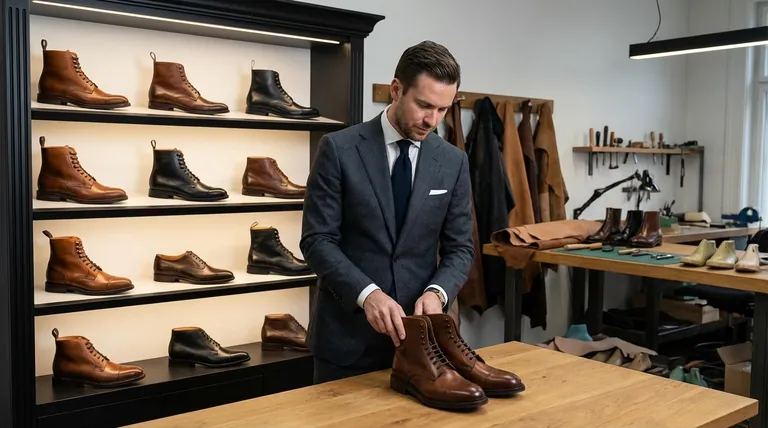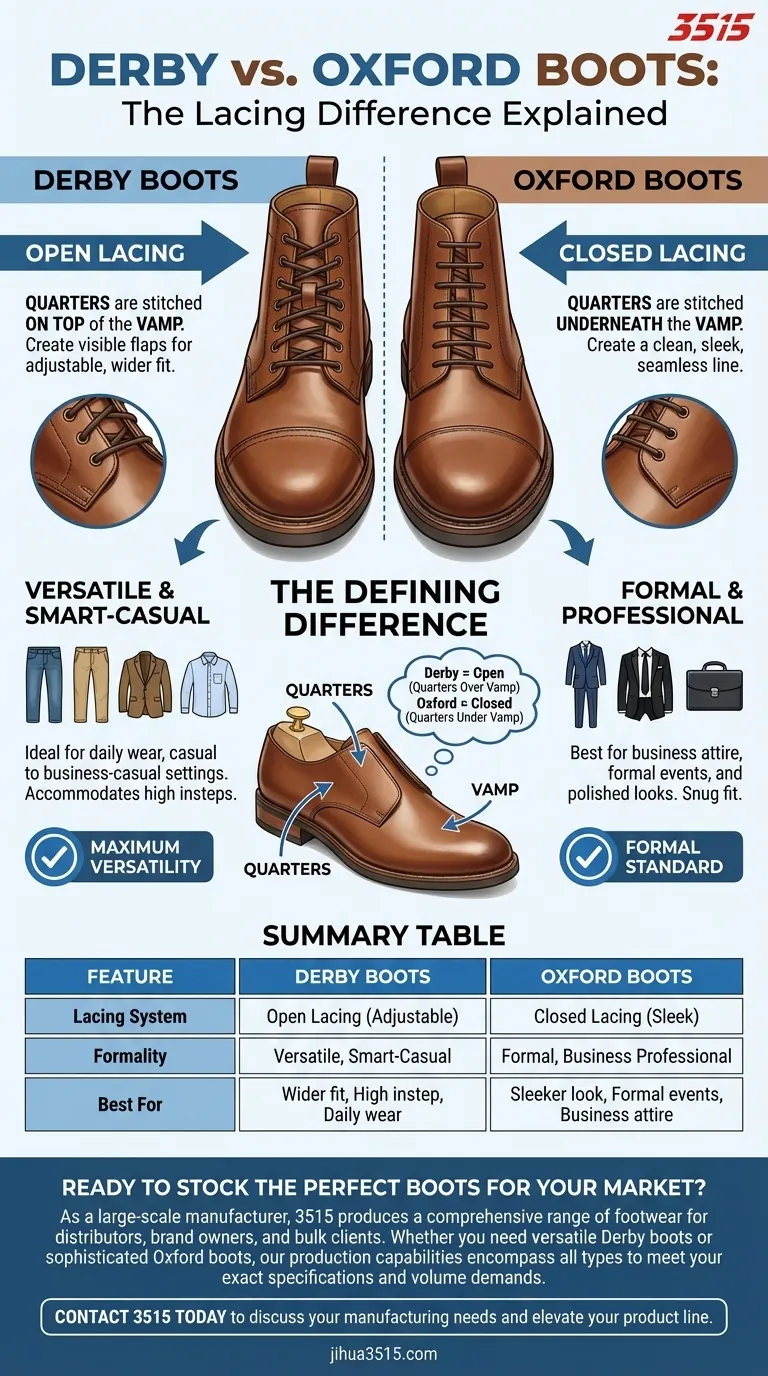To put it simply, Derby boots are most commonly confused with Oxford boots. While they can appear similar at a glance, the fundamental difference lies in their lacing system, which dictates their formality, fit, and overall versatility.
The core distinction is this: Derby boots feature an "open" lacing system, making them more versatile and accommodating, while Oxford boots use a "closed" lacing system, giving them a sleeker, more formal appearance.

The Defining Difference: Open vs. Closed Lacing
The confusion between these two iconic styles stems from a single, subtle construction detail. Understanding this detail is the key to telling them apart instantly.
Understanding the Derby's Open Lacing
The defining feature of a Derby is that the pieces of leather with the shoelace eyelets, known as the quarters, are stitched on top of the front part of the boot, known as the vamp.
This construction creates two visible flaps that open wide, which is why it's called "open lacing." This design allows for greater adjustability and a more comfortable fit, especially for those with a higher instep.
The Anatomy of the Oxford's Closed Lacing
In contrast, an Oxford's quarters are stitched underneath the vamp. The eyelets are punched directly into the leather that flows seamlessly from the front of the boot.
This "closed lacing" method creates a clean, uninterrupted line across the top of the foot. The result is a much sleeker and more formal silhouette.
Why This Small Detail Matters
This single construction choice has significant implications. The Derby's open lacing provides more flexibility and a slightly more robust, casual look. The Oxford's closed lacing creates a snugger fit and an elegant profile reserved for more formal attire.
Visualizing the Impact: Formality and Versatility
The lacing system directly translates to when and how you should wear each boot.
The Derby: The Versatile Workhorse
Because of its adaptable design, the Derby boot is a true wardrobe staple. It can be dressed down with jeans or chinos for a smart-casual look or dressed up with a sport coat or a less formal suit.
Its construction makes it the more versatile and arguably more practical choice for a wider range of daily scenarios.
The Oxford: The Formal Standard
The Oxford boot's sleek, clean lines make it the undisputed champion of formalwear. It is the correct choice for business professional attire, formal events, and any occasion that demands a polished and sophisticated look.
Pairing an Oxford with casual wear can often look out of place, as its inherent formality creates a visual disconnect.
Understanding the Trade-offs
Neither boot is inherently "better"—they simply serve different purposes. Choosing incorrectly is the most common pitfall.
The Derby's Limitation: Peak Formality
While incredibly versatile, a Derby boot will never be as formal as an Oxford. For the most stringent dress codes, such as black-tie events or conservative corporate environments, the Oxford remains the non-negotiable standard.
The Oxford's Challenge: Fit and Casual Wear
The closed lacing system of an Oxford can be restrictive and less comfortable for individuals with a high arch or wider feet. Furthermore, its inherent formality makes it difficult to pair with casual outfits without looking mismatched.
Making the Right Choice for Your Goal
Your decision should be based entirely on the role you need the boot to play in your wardrobe.
- If your primary focus is maximum versatility: The Derby is the clear winner, seamlessly transitioning from casual to business-casual settings.
- If your primary focus is formal business and special occasions: The Oxford is the definitive and most appropriate choice.
- If your primary focus is comfort for a high instep: The Derby's adjustable open-lacing system will provide a much better fit.
By recognizing the lacing system, you can confidently identify and select the perfect boot for any occasion.
Summary Table:
| Feature | Derby Boots | Oxford Boots |
|---|---|---|
| Lacing System | Open Lacing | Closed Lacing |
| Formality | Versatile, Smart-Casual | Formal, Business Professional |
| Best For | Wider fit, High instep, Daily wear | Sleeker look, Formal events, Business attire |
Ready to Stock the Perfect Boots for Your Market?
As a large-scale manufacturer, 3515 produces a comprehensive range of footwear for distributors, brand owners, and bulk clients. Whether you need versatile Derby boots for everyday wear or sophisticated Oxford boots for formal collections, our production capabilities encompass all types of shoes and boots to meet your exact specifications and volume demands.
Contact 3515 today to discuss your manufacturing needs and elevate your product line.
Visual Guide

Related Products
- Safety Footwear Wholesale Manufacturer for Custom OEM/ODM Production
- Premium Wholesale Waterproof Safety Boots High Performance Protection for Industrial Markets
- Durable Leather Work Boots Wholesale Manufacturer & Custom Factory
- Wholesale Classic Leather Lace-Up Ankle Boots for Brand Manufacturing
- Custom Wholesale Leather Safety Boots Direct Factory Manufacturing
People Also Ask
- Do snake bite boots work? Your Ultimate Guide to Effective Snake Bite Protection
- Is it normal to wear shoes in the house? A Guide to Hygiene, Comfort & Culture
- Is safety-toe as good as steel toe? Choose the Right Protection for Your Job
- What are OSHA approved shoes? Understanding the Correct Standards for Workplace Safety
- What are the differences between steel toe, composite toe, and alloy toe Wellington boots? Choose the Right Safety Toe for Your Job



















